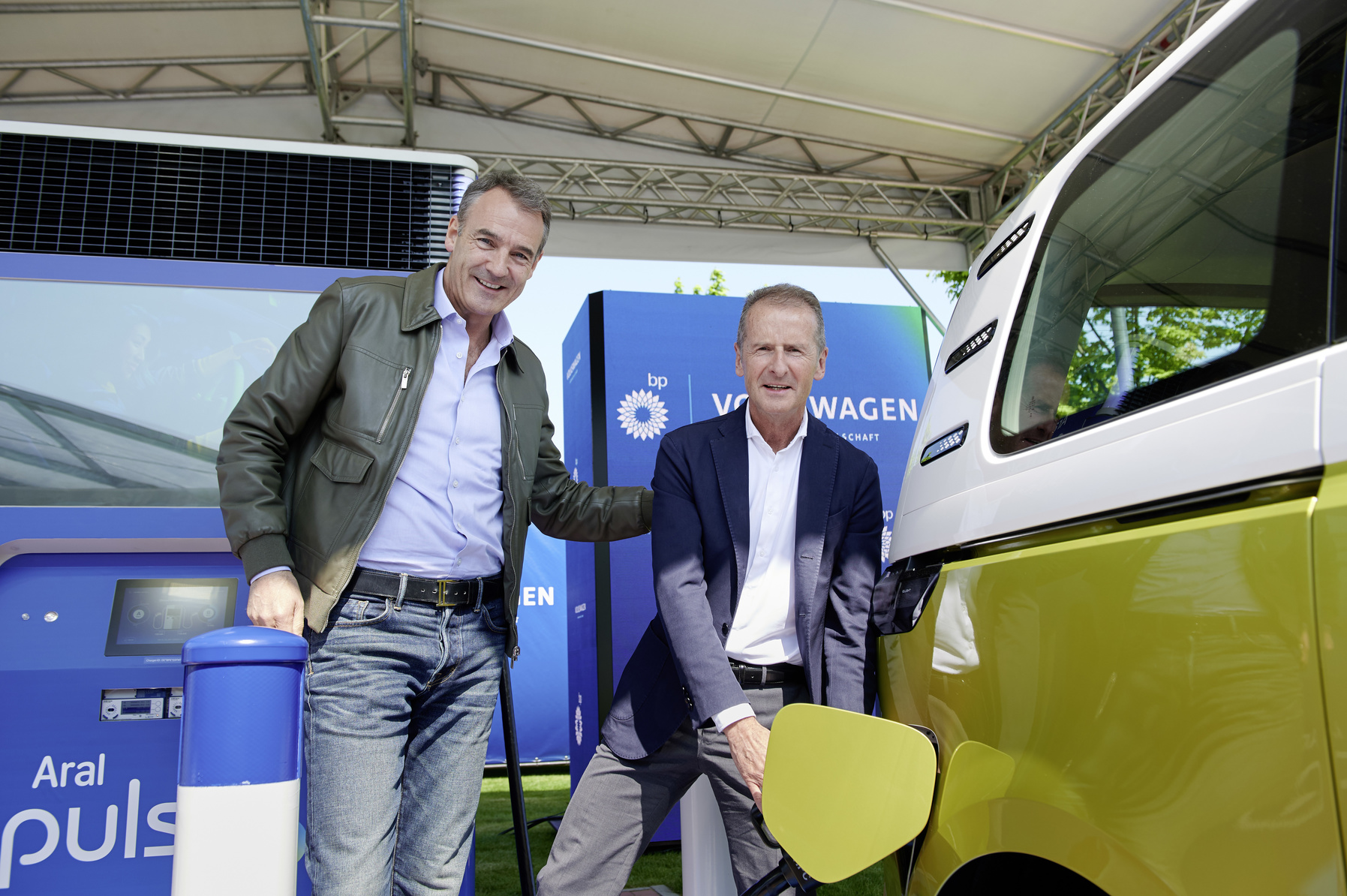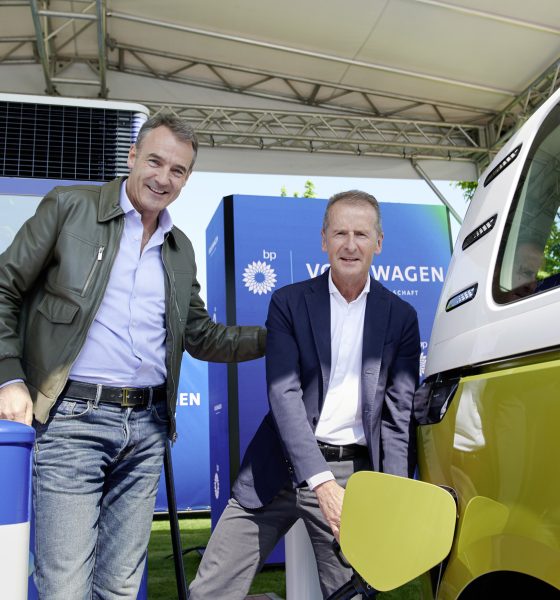

News
Volkswagen partners with bp for EV fast charging rollout in Europe
Volkswagen will partner with bp to launch a strategic partnership to roll out up to 4,000 fast-charging electric vehicle charge points in Germany and the United Kingdom within the next two years.
The first charger was unveiled in Dusseldorf, Germany on Thursday, which will be the first of perhaps 8,000 total charging points across Germany, the UK, and other European countries by 2024. Initially, the Dusseldorf fast charger is now live and is the first of at least 4,000.
The partnership will utilize Volkswagen’s Flexpole 150kW charging units, which each offer two charge points and have an integrated battery system, which enables a high-powered grid connection to make fast charging possible. The Flexpole units can be connected to a low voltage grid, which removes the need for a dedicated substation and costly and time-consuming construction projects. The Flexpole chargers can provide up to 160 kilometers, or roughly 100 miles of driving range in as little as 10 minutes, depending on the vehicle.
Phase One of the rollout will see an additional 4,000 total charge points at bp’s Aral retail sites in Germany and bp retail sites in the United Kingdom over the next 24 months, Volkswagen said. Up to 8,000 total fast-charging points could be available by the end of 2024, but there are no guarantees to the supplemental 4,000 locations, it seems. However, bp is “rapidly expanding its EV charging network, including at its extensive and conveniently located network of retail sites,” it said. EV drivers are able to charge in safe, well-lit stations that have food and drinks and other convenience features.
“Volkswagen has been pioneering the transformation to e-mobility across Europe,” Volkswagen CEO Herbert Diess said. “Today, we have the broadest offer of electric cars in the market and sold more EVs in the region than any other carmaker last year. Investing in everything from software, to batteries and charging is part of our strategy to make individual mobility safer, more convenient, and fully climate-neutral. The decarbonization of Europe’s economy requires close collaboration across borders and sectors. We’re pleased to team up with bp to accelerate the rollout of the fast-charging network across Europe.”
Volkswagen’s electric vehicle sales soar in Q1, led comfortably by ID.4
The Volkswagen-bp charging locations will be integrated into the navigation systems of Volkswagen, seat, and ŠKODA vehicles, and also into Volkswagen’s charging application, Elli.
Volkswagen’s Power Day outlined a need for more EV charging infrastructure in Europe, and plans to launch at least 18,000 new charge points in Europe with several different partners by 2025. Volkswagen also wants to install at least 17,000 charging points in China by the end of 2025.
“As we promised at our Power Day, we are driving the expansion of charging infrastructure in Europe at high speed,” Thomas Schmall, Member of the Board of Management of Volkswagen AG, said. “Together with bp, we will bring thousands of fast-charging stations to life within a very short time. Rapid expansion of the charging network is crucial now. To make that happen, our pioneering flexible, fast chargers offer a perfect solution, since the time and costs required for installation are minimal.”
The VW Flexpole chargers are produced in Suzhou, China, and Hanover, Germany. They can be installed almost anywhere needed or where a charging infrastructure is not yet in place. When connected to the low voltage grid, the station becomes a permanent charging point without the additional cost and effort required for a comparable conventional fast-charging station,” Volkswagen said.
I’d love to hear from you! If you have any comments, concerns, or questions, please email me at joey@teslarati.com. You can also reach me on Twitter @KlenderJoey, or if you have news tips, you can email us at tips@teslarati.com.

Elon Musk
Elon Musk and Tesla AI Director share insights after empty driver seat Robotaxi rides
The executives’ unoccupied tests hint at the rapid progress of Tesla’s unsupervised Robotaxi efforts.

Tesla CEO Elon Musk and AI Director Ashok Elluswamy celebrated Christmas Eve by sharing personal experiences with Robotaxi vehicles that had no safety monitor or occupant in the driver’s seat. Musk described the system’s “perfect driving” around Austin, while Elluswamy posted video from the back seat, calling it “an amazing experience.”
The executives’ unoccupied tests hint at the rapid progress of Tesla’s unsupervised Robotaxi efforts.
Elon and Ashok’s firsthand Robotaxi insights
Prior to Musk and the Tesla AI Director’s posts, sightings of unmanned Teslas navigating public roads were widely shared on social media. One such vehicle was spotted in Austin, Texas, which Elon Musk acknowleged by stating that “Testing is underway with no occupants in the car.”
Based on his Christmas Eve post, Musk seemed to have tested an unmanned Tesla himself. “A Tesla with no safety monitor in the car and me sitting in the passenger seat took me all around Austin on Sunday with perfect driving,” Musk wrote in his post.
Elluswamy responded with a 2-minute video showing himself in the rear of an unmanned Tesla. The video featured the vehicle’s empty front seats, as well as its smooth handling through real-world traffic. He captioned his video with the words, “It’s an amazing experience!”
Towards Unsupervised operations
During an xAI Hackathon earlier this month, Elon Musk mentioned that Tesla owed be removing Safety Monitors from its Robotaxis in Austin in just three weeks. “Unsupervised is pretty much solved at this point. So there will be Tesla Robotaxis operating in Austin with no one in them. Not even anyone in the passenger seat in about three weeks,” he said. Musk echoed similar estimates at the 2025 Annual Shareholder Meeting and the Q3 2025 earnings call.
Considering the insights that were posted Musk and Elluswamy, it does appear that Tesla is working hard towards operating its Robotaxis with no safety monitors. This is quite impressive considering that the service was launched just earlier this year.
Elon Musk
Starlink passes 9 million active customers just weeks after hitting 8 million
The milestone highlights the accelerating growth of Starlink, which has now been adding over 20,000 new users per day.

SpaceX’s Starlink satellite internet service has continued its rapid global expansion, surpassing 9 million active customers just weeks after crossing the 8 million mark.
The milestone highlights the accelerating growth of Starlink, which has now been adding over 20,000 new users per day.
9 million customers
In a post on X, SpaceX stated that Starlink now serves over 9 million active users across 155 countries, territories, and markets. The company reached 8 million customers in early November, meaning it added roughly 1 million subscribers in under seven weeks, or about 21,275 new users on average per day.
“Starlink is connecting more than 9M active customers with high-speed internet across 155 countries, territories, and many other markets,” Starlink wrote in a post on its official X account. SpaceX President Gwynne Shotwell also celebrated the milestone on X. “A huge thank you to all of our customers and congrats to the Starlink team for such an incredible product,” she wrote.
That growth rate reflects both rising demand for broadband in underserved regions and Starlink’s expanding satellite constellation, which now includes more than 9,000 low-Earth-orbit satellites designed to deliver high-speed, low-latency internet worldwide.
Starlink’s momentum
Starlink’s momentum has been building up. SpaceX reported 4.6 million Starlink customers in December 2024, followed by 7 million by August 2025, and 8 million customers in November. Independent data also suggests Starlink usage is rising sharply, with Cloudflare reporting that global web traffic from Starlink users more than doubled in 2025, as noted in an Insider report.
Starlink’s momentum is increasingly tied to SpaceX’s broader financial outlook. Elon Musk has said the satellite network is “by far” the company’s largest revenue driver, and reports suggest SpaceX may be positioning itself for an initial public offering as soon as next year, with valuations estimated as high as $1.5 trillion. Musk has also suggested in the past that Starlink could have its own IPO in the future.
News
NVIDIA Director of Robotics: Tesla FSD v14 is the first AI to pass the “Physical Turing Test”
After testing FSD v14, Fan stated that his experience with FSD felt magical at first, but it soon started to feel like a routine.

NVIDIA Director of Robotics Jim Fan has praised Tesla’s Full Self-Driving (Supervised) v14 as the first AI to pass what he described as a “Physical Turing Test.”
After testing FSD v14, Fan stated that his experience with FSD felt magical at first, but it soon started to feel like a routine. And just like smartphones today, removing it now would “actively hurt.”
Jim Fan’s hands-on FSD v14 impressions
Fan, a leading researcher in embodied AI who is currently solving Physical AI at NVIDIA and spearheading the company’s Project GR00T initiative, noted that he actually was late to the Tesla game. He was, however, one of the first to try out FSD v14.
“I was very late to own a Tesla but among the earliest to try out FSD v14. It’s perhaps the first time I experience an AI that passes the Physical Turing Test: after a long day at work, you press a button, lay back, and couldn’t tell if a neural net or a human drove you home,” Fan wrote in a post on X.
Fan added: “Despite knowing exactly how robot learning works, I still find it magical watching the steering wheel turn by itself. First it feels surreal, next it becomes routine. Then, like the smartphone, taking it away actively hurts. This is how humanity gets rewired and glued to god-like technologies.”
The Physical Turing Test
The original Turing Test was conceived by Alan Turing in 1950, and it was aimed at determining if a machine could exhibit behavior that is equivalent to or indistinguishable from a human. By focusing on text-based conversations, the original Turing Test set a high bar for natural language processing and machine learning.
This test has been passed by today’s large language models. However, the capability to converse in a humanlike manner is a completely different challenge from performing real-world problem-solving or physical interactions. Thus, Fan introduced the Physical Turing Test, which challenges AI systems to demonstrate intelligence through physical actions.
Based on Fan’s comments, Tesla has demonstrated these intelligent physical actions with FSD v14. Elon Musk agreed with the NVIDIA executive, stating in a post on X that with FSD v14, “you can sense the sentience maturing.” Musk also praised Tesla AI, calling it the best “real-world AI” today.








